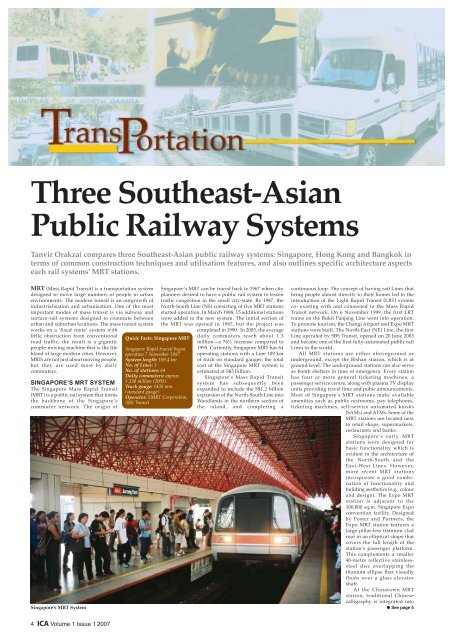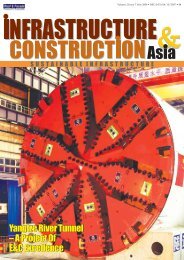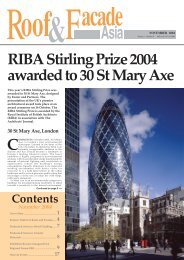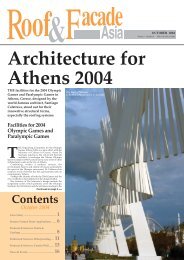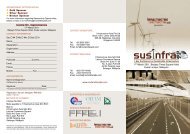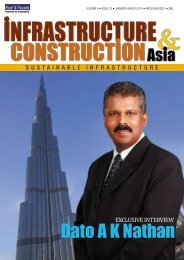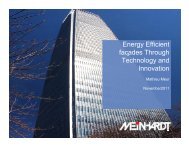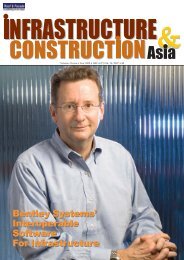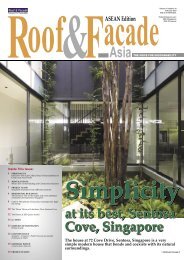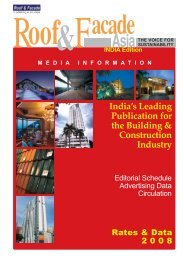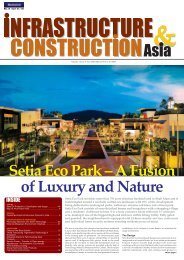ICA_Feb 07.pdf - Roof & Facade
ICA_Feb 07.pdf - Roof & Facade
ICA_Feb 07.pdf - Roof & Facade
Create successful ePaper yourself
Turn your PDF publications into a flip-book with our unique Google optimized e-Paper software.
Three Southeast-Asian<br />
Public Railway Systems<br />
Tanvir Orakzai compares three Southeast-Asian public railway systems: Singapore, Hong Kong and Bangkok in<br />
terms of common construction techniques and utilisation features, and also outlines specific architecture aspects<br />
each rail systems’ MRT stations.<br />
MRT (Mass Rapid Transit) is a transportation system<br />
designed to move large numbers of people in urban<br />
environments. The modern transit is an outgrowth of<br />
industrialisation and urbanisation. One of the most<br />
important modes of mass transit is via subway and<br />
surface-rail systems designed to commute between<br />
urban and suburban locations. The mass transit system<br />
works on a ‘fixed route’ system with<br />
little obstruction from conventional<br />
road traffic; the result is a gigantic<br />
people-moving machine that is the life<br />
blood of large modern cities. However,<br />
MRTs are not just about moving people,<br />
but they are used most by daily<br />
commuters.<br />
SINGAPORE’S MRT SYSTEM<br />
The Singapore Mass Rapid Transit<br />
(MRT) is a public rail system that forms<br />
the backbone of the Singapore’s<br />
commuter network. The origin of<br />
Singapore’s MRT System<br />
Quick Facts: Singapore MRT<br />
Singapore Rapid transit began<br />
operation 7 November 1987<br />
System length: 109.4 km<br />
No. of Lines: 3<br />
No. of stations: 64<br />
Daily commuters: approx.<br />
1.338 million (2005)<br />
Track gauge: 1435 mm<br />
(standard gauge)<br />
Operator: SMRT Corporation,<br />
SBS Transit<br />
Singapore’s MRT can be traced back to 1967 when city<br />
planners desired to have a public rail system to lessen<br />
traffic congestion in the small city-state. By 1987, the<br />
North-South Line (NS) consisting of five MRT stations<br />
started operation. In March 1988, 15 additional stations<br />
were added to the new system. The initial section of<br />
the MRT was opened in 1987, but the project was<br />
completed in 1990. In 2005, the average<br />
daily commuters reach about 1.3<br />
million—a 76% increase compared to<br />
1995. Currently, Singapore MRT has 64<br />
operating stations with a Line 109 km<br />
of track on standard gauges; the total<br />
cost of the Singapore MRT system is<br />
estimated at S$5 billion.<br />
Singapore’s Mass Rapid Transit<br />
system has subsequently been<br />
expanded to include the S$1.2 billion<br />
expansion of the North-South Line into<br />
Woodlands in the northern section of<br />
the island, and completing a<br />
continuous loop. The concept of having rail Lines that<br />
bring people almost directly to their homes led to the<br />
introduction of the Light Rapid Transit (LRT) system<br />
co- existing with and connected to the Mass Rapid<br />
Transit network. On 6 November 1999, the first LRT<br />
trains on the Bukit Panjang Line went into operation.<br />
To promote tourism, the Changi Airport and Expo MRT<br />
stations were built. The North-East (NE) Line, the first<br />
Line operated by SBS Transit, opened on 20 June 2003<br />
and became one of the first fully-automated public rail<br />
Lines in the world.<br />
All MRT stations are either aboveground or<br />
underground, except the Bishan station, which is at<br />
ground level. The underground stations can also serve<br />
as bomb shelters in time of emergency. Every station<br />
has four or more general ticketing machines, a<br />
passenger service centre, along with plasma TV display<br />
units providing travel time and pubic announcements.<br />
Most of Singapore’s MRT stations make available<br />
amenities such as public restrooms, pay telephones,<br />
ticketing machines, self-service automated kiosks<br />
(SAMs) and ATMs. Some of the<br />
MRT stations are located next<br />
to retail shops, supermarkets,<br />
restaurants and banks.<br />
Singapore’s early MRT<br />
stations were designed for<br />
basic functionality which is<br />
evident in the architecture of<br />
the North-South and the<br />
East-West Lines. However,<br />
more recent MRT stations<br />
incorporate a good combination<br />
of functionality and<br />
building aesthetics (e.g., colour<br />
and design). The Expo MRT<br />
station is adjacent to the<br />
100,000 sq.m. Singapore Expo<br />
convention facility. Designed<br />
by Foster and Partners, the<br />
Expo MRT station features a<br />
large pillar-less titanium clad<br />
roof in an elliptical shape that<br />
covers the full length of the<br />
station’s passenger platform.<br />
This complements a smaller<br />
40-metre reflective stainlesssteel<br />
disc overlapping the<br />
titanium ellipse that visually<br />
floats over a glass elevator<br />
shaft.<br />
At the Chinatown MRT<br />
station, traditional Chinese<br />
calligraphy is integrated into<br />
● See page 5<br />
4 <strong>ICA</strong> Volume 1 Issue 1 2007


